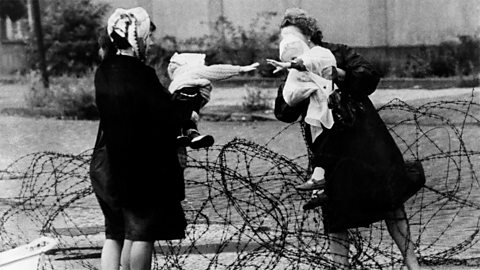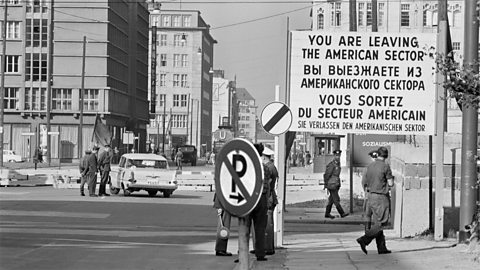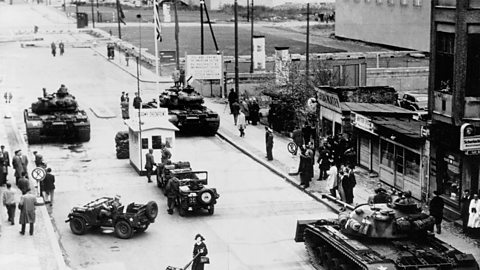Key points
- At the Yalta Conference in 1945, after World War Two, it was decided that Germany would be split into four zones. The Soviet Union, UK, America and France would each control a zone. Berlin, which was in the Soviet zone, would also be divided into four.
- In August 1961, the Soviet Union began to build a wall around West Berlin, which was controlled by the USA, UK, and France. The Berlin Wall remained in place until 1989. It became a symbol of the Cold War and the division between East and West.

What is happening in this picture?
On 13 August 1961, a barbed wire fence was erected along the border between East and West Berlin. This fence was quickly replaced by a tall concrete wall, which was patrolled by armed guards. This photograph gives an insight into the human experience of the Berlin Wall. By dividing the city, friends, family and loved ones were separated and were unable to cross the border to meet.
Berlin in 1961
In 1961, Berlin was in the Soviet-controlled zone of East Germany and was split into East Berlin and West Berlin. The agreement made at the Yalta Conference in 1945 had said the division of Germany was supposed to be temporary, until free and fair elections could be held. It was clear by 1961 that this was not going to happen.
The economy of West Germany, controlled by the UK, America and France, was thriving. Between 1945 and 1961, over 3 million East German citizens migrated to West Germany seeking better opportunities. Before the construction of the Berlin Wall, it was easy to move freely between the Soviet sector and the West. A sign marked the crossing point between the two sides.

Many well-educated and professional workers were leaving as they were able to earn better wages in West Germany, which consequently had a terrible impact on the East German economy. It has been argued that this rejection of communismA system of running a country in which all means of production such as tools, factories and raw materials, are owned by the community as a whole. Private property does not exist and each individual contributes according to their ability and receives according to their needs. This means there is no hierarchy of social class. was a propagandaPutting forward biased information to persuade people to believe a particular point of view. disaster for East Germany and the communist regime.
At the Vienna Summit in June 1961, Soviet leader Nikita KhrushchevNikita Khrushchev became the Communist leader of the Soviet Union after Stalin's death in 1953 and held the position until 1964. He was critical of Stalin's brutal approach to ruling. insisted that the US give up their control of West Berlin and allowed it to become part of East Germany, controlled by the Soviets. American President John F. Kennedy said he could not agree to such a demand.
The Vienna Summit, 1961
At the Vienna Summit in June 1961, Soviet leader Nikita KhrushchevNikita Khrushchev became the Communist leader of the Soviet Union after Stalin's death in 1953 and held the position until 1964. He was critical of Stalin's brutal approach to ruling. insisted that the US give up their control of West Berlin and allow it to become part of East Germany, controlled by the Soviets. American President John F. Kennedy said he could not agree to such a demand.
Building the Berlin Wall
On 13 August 1961, a barbed wire fence was erected along the border between East and West Berlin. The Soviets claimed the purpose of the fence was to stop espionageSpying on people, obtaining confidential information about someone or something without their permission.. They accused agents from the West of coming into the East and spying on them. This fence was quickly replaced by a tall concrete wall, which went all around West Berlin, and was patrolled by armed guards. East Berlin citizens were told that if they tried to leave and escape into West Berlin they would be considered dissenterSomeone who opposes the beliefs, lifestyle or opinion of a dominant group in society., and that they would be killed.
Life with the Berlin Wall
The Berlin Wall was built with no prior warning, and many people were separated from their families and loved ones. People from East Berlin were barred from crossing the wall and entering West Berlin, and the wall was patrolled by armed guards who were ordered to shoot escapees.
West Berlin prospered after the building of the Berlin Wall as they benefited from investment from America. Troops from the US, UK and France remained stationed in the West after the construction of the wall. There was road access from West Berlin to West Germany, so the population could still travel with more freedom than East German citizens.
East Berlin was not as economically successful as West Berlin. Consumer goods were harder to come by and many East Berlin citizens describe their life behind the wall as claustrophobic and plagued by shortages. For example, the waiting list to purchase a car was as long as ten years. The psychological impact of the Wall became known as ‘Wall sickness’, as people struggled to cope with the impact of the division of Germany.
However, the communist government continued to try to show the superiority of communism over capitalism. For example, a huge TV Tower was built in East Berlin, near the border with the West. At 368 metres tall, it was intended to be both a symbol of Communist power and of Berlin. It continues to be the tallest building in Germany.
What was the Stasi?
The Stasi was a secret police organisation that extensively spied on the citizens of East Germany. They held files on over 6 million East German citizens, one third of the population.
The Stasi would intercept letters, bug rooms, tap phone lines and encourage people to report friends or family who said anything negative about the communist regime. Their presence created a great sense of mistrust as no one knew if a friend, relative or colleague was secretly a Stasi agent or informant. They punished dissenters with imprisonment and physical and psychological torture. This showed the extent to which the East German communist government wanted to control the people.
When the wall came down, the people of East Germany were given the right to access files the Stasi may have held on them. Many people found the Stasi had hundreds of pages of records on them.
Escaping East Berlin
There were many people in East Berlin who were desperate to seek a more prosperous life in the West. Between 1961 and 1989, thousands of people who were living in the East successfully escaped to the West. But in that time at least 140 people lost their lives trying to cross the divide.
How did people try to escape across the wall?
On 15 August 1961, an East German border guard called Konrad Schumann saw his chance to escape while the concrete wall was being constructed. He ran and jumped over the barbed wire, landing on the other side. Schumann claimed refugee status and later settled in Bavaria in West Germany.
When the wall was first constructed, there were some buildings in the East that had windows facing the West. Some people jumped out of these west-facing windows and were caught by the fire brigade in the West, until these windows were bricked up.
Other famous escape attempts included tunnelling under the wall, hiding in secret compartments in cars that were allowed to travel from East to West, floating over the wall in a home-made hot air balloon and swinging hand-over-hand across a wire between buildings on either side of the wall.
Checkpoint Charlie
Foreigners were allowed to enter East Berlin from West Berlin, and America regularly sent diplomatSomeone representing a government on official business. and officials into the Soviet sector through Checkpoint Charlie, one of the guarded crossing points between East and West. On 22 October 1961, an American diplomat and his wife were refused entry into East Berlin because they would not show the guards their documents.
In retaliation, General Clay, who was in charge of the American forces in Berlin, sent tanks to the crossing point. The incident soon escalated, and before long both US and Soviet tanks were facing each other, only 75 metres apart. Had either side opened fire, a border clash could have escalated into a full-scale war. Six days later, both sides backed down and removed their tanks. War was avoided and West Berlin remained under control of the Western allies.

John F Kennedy's visit
On 26 June 1963, US President John F. Kennedy visited West Berlin. He stood in front of the Berlin Wall and gave a speech in front of more than 100,000 West Berliners. He famously said ‘Ich bin ein Berliner’, meaning ‘I am a Berliner’, showing that America stood side-by-side with the people of West Berlin.
Listen to an extract of Kennedy's "Ich bin ein Berliner" speech
91»»±¨ Bitesize audio bites.
An extract from President John F. Kennedy’s speech to the people of Berlin on 26 June, 1963.
John F. Kennedy: Two thousand years ago the proudest boast was “civis Romanus sum”. Today, in the world of freedom, the proudest boast is “Ich bin ein Berliner”.
There are many people in the world who really don’t understand, or say they don’t, what is the great issue between the free world and the communist world. Let them come to Berlin. There are some who say that communism is the wave of the future. Let them come to Berlin. And there are some who say in Europe and elsewhere we can work with the communists. Let them come to Berlin. And there are even a few who say that it is true that communism is an evil system, but it permits us to make economic progress. Lass’ Sie nach Berlin kommen. Let them come to Berlin.
Freedom has many difficulties and democracy is not perfect, but we have never had to put a wall up to keep our people in, to prevent them from leaving us.
The fall of the Berlin Wall
By 1989, the Eastern blocCountries in Eastern Europe that were controlled by the Soviet Union, for example Poland, Hungary and Czechoslovakia. was coming under pressure. There were protests in Polish shipyards and the Soviet Union was involved in a difficult war in Afghanistan. Mikhail Gorbachev, the leader of the Soviet Union, was now promoting policies of openness and reform.
On 9 November 1989, the East German border guards opened checkpoints and allowed people to travel freely across the border into the West. Before long, thousands of people began to flood into West Berlin and started to tear down the wall. On 13 June 1990, the East German Border Troops officially began dismantling the Wall.
The Berlin Wall marked a shift in Soviet attitude towards Berlin. They had previously been aiming to make Berlin part of the Eastern bloc. The wall was a recognition that West Berlin was going to remain capitalismA system of running a country where most businesses are owned by private companies or individuals, not the government.. The Berlin Wall was a huge propaganda victory for the West. It suggested communism needed to build a wall to keep people under their control.
In Germany today, small segments of the wall are in place as a reminder of the time when the city was divided. A line of cobbles marks the border where the wall once stood.
Test your knowledge
Play the History Detectives game! gamePlay the History Detectives game!
Analyse and evaluate evidence to uncover some of history’s burning questions in this game.

More on The Cold War
Find out more by working through a topic
- count3 of 4

- count4 of 4

- count1 of 4
